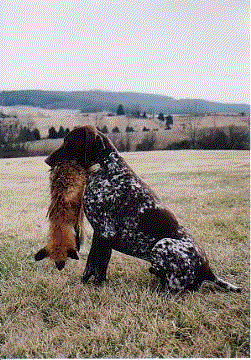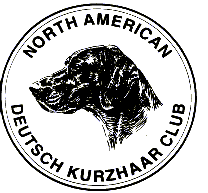Deciphering an Ahnentafel
If you are like me, you don't read German very well. This can make deciphering titles on an Ahnentafel (pedigree) a little difficult, especially since there are so many different testing clubs out there that award their own titles.
So, I have tried to put together a short menu of the most common title abbreviations you might find on a dog's Ahnentafel and what they mean just as a matter of reference. Perhaps this will help take a little mystery out of all those little letters and numbers for you.
Field titles:
D = Derby
This is the test for puppies born after the first of October of the year before last. It is basically a natural ability test and is held only in the spring. You will see a "D" followed by a number. This stands for Prize 1,2 or 3 which is what is awarded based on the pup's performance if he passes the test. A pup may enter more than one Derby and each result will be recorded on the pedigree.
(J) = "Youth"
Dogs that pass a Derby in their first year receive this notation (J) for "youth" behind the assigned prize category (e.g. D1(J))
(*) = Andreas star
If a dog intentionally or by chance shows excellent work on in tracking an unseen rabbit or hare during a given test, it is marked with an Andreas star, but this has no effect on the overall scoring of the test. (e.g. D1*)
S = Solms
Held in the autumn of the same year as the Derby, this test is the next level up from the Derby. A number indicating that the dog was awarded a Prize 1,2, or 3 will follow the "S". The Solms may be entered more than once, and each result will be recorded on the pedigree.
AZP = Alterszuchtprüfung
This is the "Older Dog Breeding Test" and is basically a trial for dogs that for some reason were unable to be tested in a Solms test. The rules are the same as for the Solms, but a higher level of performance is expected in consideration of the dog's age. These dogs should not be over 6 years old.
IKP = International Kurzhaar-Prüfung
This test is held every other year, alternating with the Kleeman Trial. It is regarded as a "warm up" for the Kleeman.
Kl. Ausl. Prfg. = Kleeman Ausleseprüfung
This is the "Dr. Kleeman Trial". Dogs that pass this test will have "Kl. Ausl. Prfg." Stamped on their Ahnentafel. Dogs that receive a Prize 1 at this test are awarded the "KS" (Kurzhaar Seiger) title. In order to qualify to test in a Kleeman, the dogs must have a conformation rating of at least "SG" (very good), must have first prizes in both the VGP (Verbandsgebrauchesprüfung) and either Vbr. (Verlorenbringen) or SW (Verbandsschweissprüfung), pass of the hardness test (mS), plus two first prizes in Derby, Solms or AZP field tests. This is basically a field test with conformation qualifications.
KS = Kurzhaar Seiger
This is the "Shorthair Champion" title awarded to dogs that achieve a Prize 1 in the Dr. Kleeman Trial. This title is added to the name of the dog rather than listed after the name with the other titles. (E.g. Quasi KS vom Bieberstein)
Diana Prfg. = Diana Ausleseprüfung
This title is no longer in use as of 1957. Prior to this, dogs and bitches were judged separately, the dogs at the Dr. Kleeman Trial and the bitches at the Diana. Since 1957, both sexes have been judged together although an award is given for the Best Dog and Best Bitch at each Kleeman (Kleeman Sieger/Siegerin).
The above titles are awarded only to Kurzhaars by the Kurzhaar Verband. However, there are other titles that may be awarded by the Jagdgebrauchshundverband (JGVH). This organization includes all of the versatile hunting dog clubs in Germany, regardless of breed.
VJP = Verbandsjugendprüfung
This is a national breed club youth trial, roughly the equivalent of a Derby. These dogs are not awarded a Prize number, but rather a score that appears behind the "VJP". E.g. VJP 68
HZP = Verbandsherbstzuchtprüfung
The autumn trial of the national breed club. The equivalent of the Solms. These dogs are not awarded a Prize number, but rather a score that appears behind the "HZP". E.g. HZP 181
VGP = Verbandsgebrauchesprüfung
This is the Association Utility test. It is designed to test finished versatile hunting dogs in all aspects of field, forest, and water work. A score and Prizes 1,2 or 3 are awarded to dogs that pass this test. Passing this test qualifies a dog for registration in the German Register of Utility Dogs (DGStB).
Other titles:
Btr. = Bringtreueprüfung
The retrieving reliability test. This requires finding a fox placed in undergrowth at least 3 hours previous to the test. The dog is released at least 150 yds. from the fox and must search with no help from the handler.
Vbr. = Verlorenbringen
Retrieve of wounded game. Requires trailing and retrieving a hare over a distance of about 300 yds. while the trail is still warm but the dog has not seen the game.
AH = Ambruster Halt award
This title is given for obedience in the presence of game
SW = Verbands-Schweissprüfung
This is the specialty blood tracking title, and will be followed by a Prize score of 1,2 or 3. An "SW" is a 20 hour specialty blood track, while an "SW" followed by a "/" is a 40 hour track. E.g. an SW /2 is a Prize 2 awarded for a 40 hour blood track.
Sch. H = Schutzhund
You will occasionally see the Schutzhund title on an Ahnentafel followed by a Prize 1,2, or 3. This is the test for police or protection dogs and requires elements of obedience, tracking and seeking and detaining criminals.
Conformation Titles:
WS = Welt Sieger
BS = Bundes Sieger
RS = Reichs Sieger
These are all show titles that may be won at a single show (e.g. the Welt Seiger show). They are awarded to the Best of Breed winner if that dog has a "V" conformation rating. The RS or Reichs Sieger is no longer in use.
ES = Europa Sieger
This is for "European Champions". To be awarded this title, a dog must obtain four F.C.I International Canine Federation Challenge Certificates (CACIB) or National Challenge Certificates (CAC).
VDH Champion = Verband für das Deutsche Hundewesen
This is the Society for German Dog Breeds Champion. It is given if four CACIBs have been awarded under four different judges.
CACIB = Certificates d'Aptitude au Championnat International de Beaute
Conformation title awarded only at international shows. Dogs must usually be older than 18 months.
CAC = Certificates d'Aptitude au Championnat
German conformation champion





